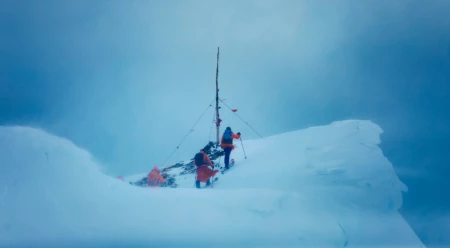Keep Red Lady Free: The Fun-Loving Activists of Crested Butte
Activism doesn’t have to be all wonk and politics. The townspeople of Crested Butte, Colorado, show us that when you’re fighting for what you love, you can still have fun.
At one point on our way toward Red Lady’s summit, Julie Nania stops in her favorite aspen grove as we wait for the rest of the red-clad women to appear. She looks up at the bare treetops swaying in the wind and says something about how our oldest and best stories are those that have bubbled up from the land.
Mount Emmons, named after a famous 19th century geologist, has been locally renamed Red Lady. Circa 1950, a Crested Butte born-and-raised miner was walking home from a long shift in the coal mine, looked up and saw a vision of a woman glowing as sun reflected off auburn-hued rocks in the mountain’s large bowl. At that time, nobody realized that she held the third-largest known deposit of molybdenum in the world, a mineral that requires large-scale operations to extract and is used to harden steel.
At the summit, red prayer flags dance wildly as red skirts thrash around the women tying the flags to the wooden summit post of the Red Lady. “May she forever be mine free,” Nania shouts, not seeming to notice the wind whipping her hair into her mouth. The women, with red lace, sequins, parasols and polyester weaved into their ski outfits, are beaming.
Red Lady’s molybdenum deposit, discovered in 1976 and thought to have a market value of $7 billion at the time, commenced the longest-running mine battle in North America: a battle that’s still ongoing, the fate of Red Lady still unknown.
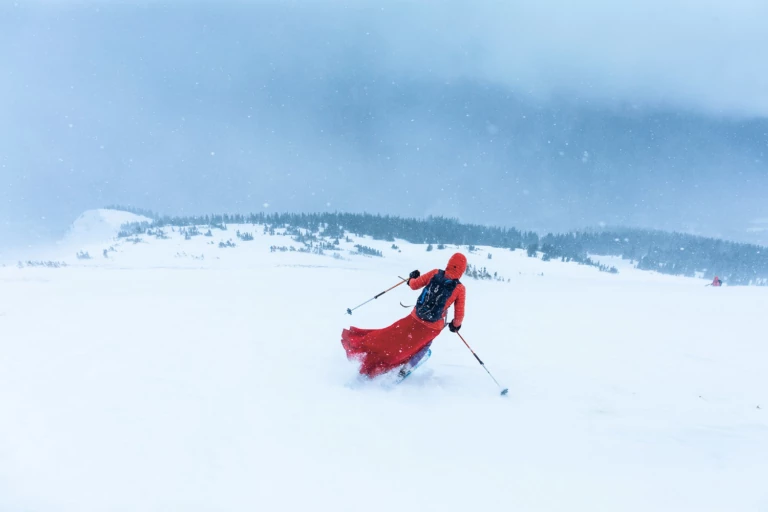
The author (Red Lady #35) navigates the windswept shoulder of Red Lady Bowl. Photo: Forest Woodward
“The fact that the mountain is still intact is a testament to the perseverance of the community,” says Roger Flynn, an adjunct professor at University of Colorado School of Law who teaches Natural Resource and Mining Law. He is also the founding lawyer of the Western Mining Action Project and for 25 years has been representing the local environmental organization that formed in response to the original mine proposal—High Country Conservation Advocates (HCCA). Small but scrappy, HCCA has continuously thrown bureaucratic and legal sticks in the mining companies’ spokes, while helping galvanize community advocacy and celebration of the mountain.
Nania, age 33, is a former law student of Flynn’s. With sparkling blue eyes and a shocking effervescence, she’s given her last 10 years to working on complicated water law around the West (including federal reserve water-rights issues and climate-adaptation management planning with the Navajo Nation). She defends, and appreciates, Red Lady’s wildness around the clock. Because Crested Butte’s mining issues and water protection are intimately connected—the EPA reports that hard-rock mining is the largest toxic polluter in the United States and more than 40 percent of headwaters in western watersheds have been polluted by mining—Nania now leads HCCA’s strategy around Red Lady. A typical day for her starts at 6 a.m. with a few hours of work, then possibly assisting a colleague with water sampling on her way out for a backcountry ski, a quick change in the car before heading to meetings, then off to hockey or dance, and back to work until 10 p.m. or later.
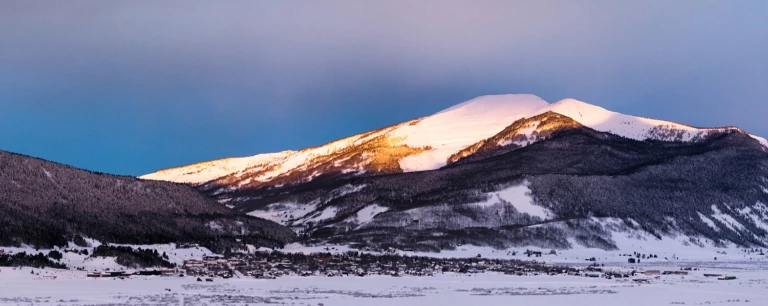
Red Lady peers down from 12,343 feet onto Crested Butte. Once the summer landing zone for the Ute Indians, she shares a similar story with other rural Coloradan outposts: economies of mining, ranching and, now, tourism. Photo: Forest Woodward
The rights to Red Lady have been passed between four different companies in the last 40 years. In 2004, one of those companies purchased federal public land in the belly of Red Lady Bowl for $5 an acre (the standard cost for patenting mining claims), privatizing the public land for mining uses. Now, parts of Red Lady, and the right to extract the minerals beneath her surface, are currently held by one of the largest mining companies in the world: Freeport-McMoRan.
Red Lady came under threat due to the 1872 Mining Law, the current operating framework in the US that has changed very little since it was signed into law “to encourage mineral development in order to settle the West.” Under the law’s current interpretation, mining claims take precedence over all other public land uses, including clean drinking water, hunting, ranching and recreation. In other words, the federal government cannot say no to a mining proposal. However, for Red Lady, salvation may come from a unique twist of fate—Freeport-McMoRan has decided that mining here is no longer worth it. They already own and operate two of the largest primary-producing molybdenum mines in the country, and the element can be extracted as a by-product from existing copper mines, making new molybdenum extraction less necessary for overall production.
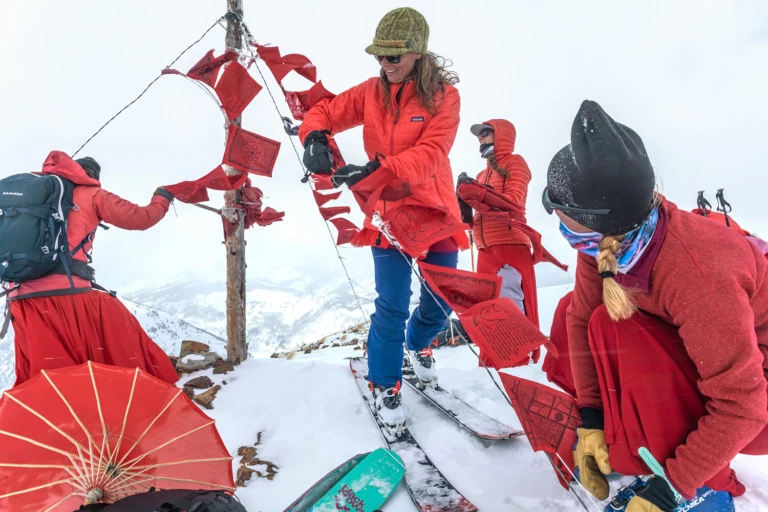
Fueled by a purpose beyond themselves and with a love of their home, these Red Lady skiers laugh their way through cold gusts, face-stinging snow and variable (shit) skiing. Photo: Forest Woodward
Recently, Freeport-McMoRan signed a memorandum of understanding with the town of Crested Butte, Gunnison County, and state and federal agencies, stating that the company is dedicated to finding a mutually acceptable solution to dispose of its claims on Red Lady. But, there are complications like acid drainage from an old mine within Freeport-McMoRan’s claim that they are responsible for addressing through the water treatment plant, which is due for an expensive upgrade and already costs $1 million to $2 million per year to operate. Crested Butte does not have the money necessary to maintain it on its own. Fortunately, the community is now working with the mining company (not against, as in years past) to clean up the site together.
Red Lady is bound up in public and private lands with a patchwork of overseers in federal, state and local governments. But the multiparty, multigenerational, often complicated story has helped lay the groundwork for this community’s concrete expression of love of place.
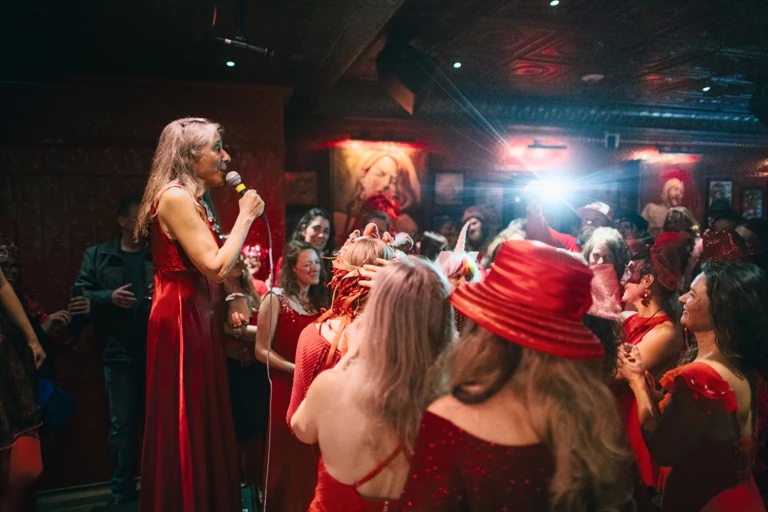
Sue Navy (Red Lady #11) has been actively involved in opposing the mine on Red Lady since 1977. At the 2019 Red Lady Salvation Ball in early March, the crowd excitedly awaits her announcement of who will be crowned Red Lady #42. Photo: Forest Woodward
“It’s place worship and part of my and many others’ daily practice here,” says Nania when reflecting on what keeps her going. “Maybe us ‘raising awareness’ for Red Lady is actually her raising our awareness.”
Some of the first community activism that HCCA organized were ski protests, where up to 40 people would lug heavy-frame packs on skinny skis through the backcountry from Crested Butte to Aspen, sleeping in ice caves overnight. Once the skiers arrived in Aspen, they rallied in the streets, garnering national attention. This was the first of many rambunctious rallies and, while this particular event is no longer organized by HCCA, they have successfully put on the Red Lady Salvation Ball for the past 42 winters. At the ball, townspeople don their flashiest reds and dance in celebration of a wild Red Lady. Beneath the flamboyant costumes are people who have spent years, or decades, on boards, as elected officials or working for nonprofits to ensure public policy reflects the community’s values. Crested Butte has actively made a decision to switch from mining to tourism for its economy, which is not free of its own challenges but values intact lands as its most cherished resource.
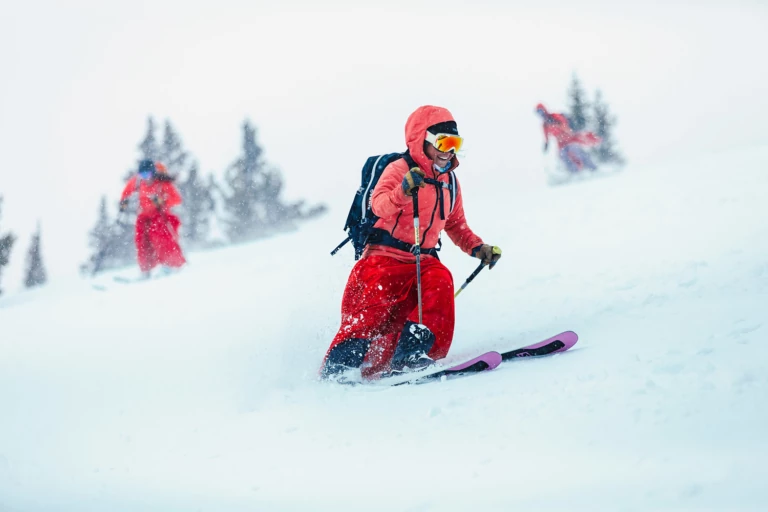
Once a Red Lady, always a Red Lady. These Crested Butte gals exhibit the symbiotic relationship between mountain and skier.
Photo: Forest Woodward
Each year, a member of the community who has shown exemplary dedication to the cause is crowned Red Lady for the following year and becomes an ambassador for the mountain. There are now 42 Red Ladies, ranging in age from mid-20s to mid-70s. Red Lady #36 is a musician who writes songs about Red Lady and performs them at fundraisers. Red Lady #12 ran the Crested Butte Mountain Heritage Museum and has been educating visitors about the mountain’s plight for over a decade. Number 30 is a writer and made the red prayer flags that you see on homes and businesses up and down the valley as symbols of support. And #11 helped start HCCA, where she currently sits as president of the board. These women (and three men) still live in the Crested Butte area, and all come together on the dance floor at the ball and ski together the day after, often wearing their dresses from the night before. A newer tradition has formed around skiing Red Lady in dresses in anticipation of the ball.
They all say, “Once a Red Lady, always a Red Lady.
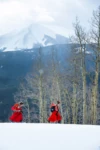
Shea Wilson (left) and Crystal Kotowski-Edmunds (Red Lady #37) perfect breathable layering systems of lace and polyester as they weave through the aspen-studded flanks of Red Lady. Photo: Forest Woodward
